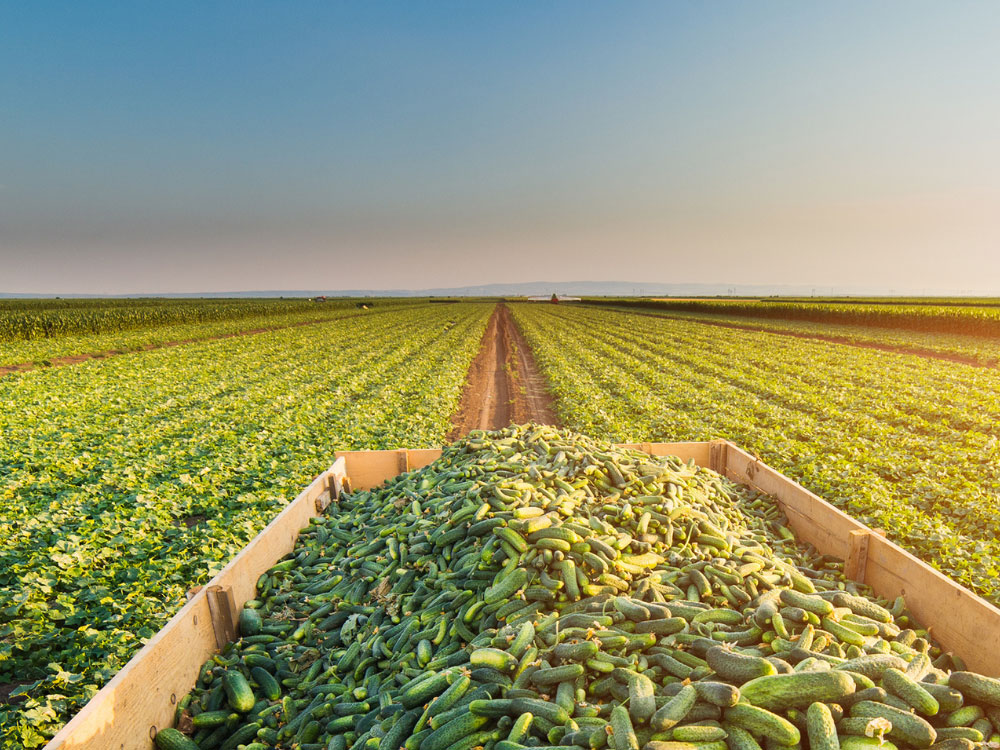ReFED's Roadmap to Reduce U.S. Food Waste by 50% was designed to provide food businesses, funders, policymakers, innovators, and more with a framework around which to align their food waste reduction efforts. It outlines seven key action areas with related solutions to prevent, rescue, and recycle food at risk of being wasted. Each month in our special "Following the Roadmap" series, we'll dig deep into one of the action areas to explore why waste occurs – and what can be done about it.
Optimize the Harvest
What's Happening
Of the nearly 17 million tons of surplus produce generated at the farm level, a staggering 82% reached maturity but was left behind after harvest. Some of it was considered inedible, for reasons including rot and infect infestation, but more than a quarter of surplus was left behind because it was considered "not marketable" – frequently because of overly strict quality or appearance standards established by stakeholders further down the supply chain. And surprisingly, another quarter of what was left behind was actually considered marketable, but it wasn't harvested for other reasons, including insufficient labor (a big challenge during the COVID-19 pandemic) or because it was planned surplus that ensure that contracts were fulfilled.
Action Area Overview
"Optimizing the harvest" means aligning what's grown with what's ultimately harvested, by avoiding over-production and then harvesting as much as possible. When it comes to wild-caught products, such as fish, some animals, and certain types of produce, it means sourcing only what is needed. Solutions in this action area include finding new ways to sell and donate what's left after harvest, such as developing innovative contract structures that don't incentivize over-production, and improving systems of communication that relay forecasted demands back up the supply chain to producers. Additionally, technological innovations that streamline individual, cross-sector, and cross-supply chain data-sharing could amplify the benefits. While these solutions manifest in less waste at production, the opportunities and responsibility to implement them lie across all supply chain actors.
Impacts
Our analysis estimates that implementing solutions to optimize the harvest can cut food waste by 3.7 million tons each year, reduce greenhouse gas emissions by 466,000 metric tons, save 11.8 billion gallons of water – and result in $8 billion of net financial benefit.
Financing Needed
We've determined that nearly $700M is needed to implement solutions in this action area. Approximately half of the capital investments needed come from Corporate Finance and Spending, as the companies and organizations that invest in development and implementation of solutions will receive the greatest benefit through additional revenue opportunities and financial returns. The next largest contributions are Impact-First Investments and an equal split between Venture Capital and Private Equity – which highlights the need for catalytic capital from philanthropic and private investors to increase participation from all types of funders. Importantly, Public Funding can play a key role in financially supporting smaller food organizations and innovators and assisting with pilot programs that can incentivize food businesses into adopting certain solutions.
Relevant Solutions
Within this and the other action areas are a range of solutions, including those that we've modeled using key data points, promising solutions that we're still gathering data on, and best practices that many organizations have already worked into their operations.
Modeled Solutions
Imperfect & Surplus Produce Channels
Surplus, off-grade, near-expiration, or imperfect produce that is packaged and distributed via alternative sales channels or directly to consumers.
Buyer Specification Expansion
Adjustment of purchasing specifications that allow for a greater variety of product grades into sales and recipes, while still ensuring that specs do not lead to in-house waste.
Gleaning
Collecting leftover produce from fields after the initial commercial harvest that would be otherwise inefficient and uneconomical to harvest, often conducted by volunteers.
Partial Order Acceptance
Processes to reject at a higher level of granularity and limit rejections of product that meet specs.
Unmodeled Solutions
Labor Matching
Use of systems, such as apps, web services, community bulletin boards, and/or word of mouth, to find farm workers to fill labor demand for harvests.
In-Field Sanitation Monitoring
Practices that can reduce contamination, microbial growth, pests, and other food safety concerns, which would otherwise lead to waste and disposal.
Field Cooling Units
Structures, either purchased or constructed, that can be brought in-field to immediately reduce the temperature of produce, resulting in decreased metabolic respiration and associated decay, moisture loss, ethylene production, and microbial growth, resulting in improved shelf-life for storage and distribution.
Innovative Grower Contracts
Mutually beneficial long-term partnerships established between buyers and producers for food crops, animal production, or other soft commodities that reduce the need for over-production or arrange whole crop purchases (of all product grades).
Smaller Harvest Lots
Purchasing smaller harvest lots to decrease harvest window time.
Best Practices
Improved Communication for Planting Schedules
Technology-enabled coordination between producers to minimize surplus planting and to match future harvest quantities with projected market demand.
Sanitation Practices & Monitoring
Practices and oversight that can reduce contamination, microbial growth, pests, and other food safety concerns, which would otherwise lead to waste and disposal.
Optimized Harvesting Schedules
Coordinated harvest planning that integrates weather patterns, demand forecasting, and growing timelines to maximize product quality and shelf-life.
On-Farm/Near-Farm Processing
Immediate post-harvest processing, such as freezing, drying, jamming, or other, to leverage freshness of products, reduce waste of surplus or damaged goods, and/or minimize transportation costs.
Local Food Systems
Collaborative network in which food is locally produced, processed, distributed, consumed, and recycled to support the health and wellness of the community and environment.
Clear Product Ownership
Defined responsibility for maintaining quality, minimizing losses, and ensuring successful transition of product as it passes hands over the course of the supply chain.

